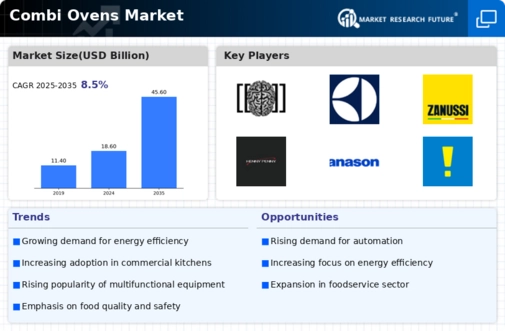Focus on Energy Efficiency
Energy efficiency is becoming a paramount concern within the Combi Ovens Market, as operators seek to reduce operational costs and environmental impact. Many manufacturers are now prioritizing the development of energy-efficient models that consume less power while maintaining high performance. This trend is supported by various government initiatives aimed at promoting energy conservation in commercial kitchens. As a result, the market for energy-efficient combi ovens is anticipated to grow significantly, with estimates suggesting a potential increase of 15% in market share over the next few years. This shift not only aligns with sustainability goals but also appeals to cost-conscious operators.
Health and Wellness Trends
The Combi Ovens Market is also influenced by the growing health and wellness trends among consumers. As more individuals prioritize nutritious and wholesome meals, food service operators are adapting their menus to include healthier options. Combi ovens, which allow for cooking methods that preserve nutrients, such as steaming, are becoming increasingly popular. This shift towards health-conscious cooking is prompting operators to invest in equipment that aligns with these dietary preferences. Consequently, the market for combi ovens is expected to see a growth rate of approximately 8% in the coming years, as establishments seek to meet the demand for healthier meal options.
Technological Advancements
The Combi Ovens Market is experiencing a surge in technological advancements that enhance cooking efficiency and precision. Innovations such as smart controls, IoT connectivity, and automated cooking programs are becoming increasingly prevalent. These features allow operators to monitor and control cooking processes remotely, ensuring consistency and quality. The integration of advanced sensors and data analytics is also contributing to improved energy efficiency, which is a critical factor for many commercial kitchens. As a result, the market is projected to grow at a compound annual growth rate of approximately 7% over the next five years, driven by the demand for high-performance cooking equipment.
Growth of the Food Service Sector
The Combi Ovens Market is benefiting from the robust growth of the food service sector, which includes restaurants, catering services, and institutional kitchens. As dining trends evolve and consumer preferences shift towards diverse and high-quality food offerings, food service operators are investing in advanced cooking technologies. The increasing number of dining establishments and the expansion of catering services are driving the demand for combi ovens, which provide flexibility and efficiency in food preparation. Market analysts project that the food service sector will continue to expand, potentially leading to a 12% increase in combi oven sales over the next few years.
Rising Demand for Versatile Cooking Solutions
The Combi Ovens Market is witnessing a rising demand for versatile cooking solutions that can accommodate various culinary techniques. Chefs and food service operators are increasingly seeking equipment that can steam, bake, roast, and grill, all in one unit. This versatility not only saves space but also reduces the need for multiple appliances, leading to cost savings in both equipment and energy consumption. The market is expected to expand as more establishments recognize the benefits of multifunctional ovens, with a projected increase in sales of around 10% in the next few years, reflecting a shift towards more efficient kitchen operations.





















